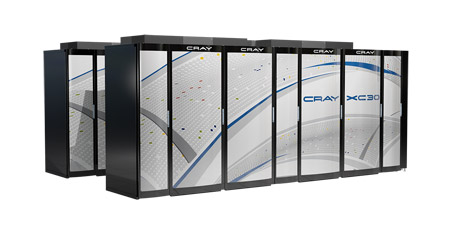Cray's New Supercomputer XC30 Delivers 66 TFlops/Cabinet
Cray unveiled its Cascade supercomputer architecture, one of the first to support Intel's upcoming Xeon Phi accelerators.
While the system has been officially launched only now, Cray has been selling these systems as early as 2010 and claims to have to have six Cascade supercomputers under contract valued at more than $100 million already.
Next to IBM's BlueGene/Q design, Cascade is the second major architecture that is claimed to scale to about 100 petaflops. The system, which carries the commercial name XC30, will run Intel's Xeon E5-2600 series processors and can, in theory, support more than 1 million cores, Cray said. Future versions of the XC architecture will also be available with Intel Xeon Phi coprocessors and Nvidia Tesla GPUs to enhance the system's floating point horsepower.
According to Cray, the XC30 can ship with up to 384 Xeon E5-2600 processors per cabinet, representing up to 3,072 cores and an initial peak performance of 66 TFlops per cabinet. There can be 32 to 128 GB of memory per node, and a memory bandwidth of up to 117 GB/s. A single fully equipped (liquid cooled) cabinet will weigh 3,450 lbs and require power supply of about 88 KW, Cray said.
Contact Us for News Tips, Corrections and Feedback
Get Tom's Hardware's best news and in-depth reviews, straight to your inbox.

Wolfgang Gruener is an experienced professional in digital strategy and content, specializing in web strategy, content architecture, user experience, and applying AI in content operations within the insurtech industry. His previous roles include Director, Digital Strategy and Content Experience at American Eagle, Managing Editor at TG Daily, and contributing to publications like Tom's Guide and Tom's Hardware.
-
cookoy Forget about the one laptop per child. The next giant leap for mankind is one supercomputer per child.Reply -
jossrik Stuff like this really makes me think of the old "super computers". What we once thought to be incredibly powerful and Bad@$$ is now in everyone's phone. We've come so far seems just like yesterday blah blah. I want 2016s computer now!Reply -
merikafyeah Efficiency is down the drain.Reply
The Titan supercomputer (a Cray XK7 system) at the Oak Ridge National Laboratory is currently the world's fastest supercomputer at 17.59 PFlops, consuming roughly 9 MW.
The IBM Sequoia (a Blue Gene/Q system) is the second fastest supercomputer at 16.32 PFlops, consuming 7.9 MW.
The XC30 delivers 66 TFlops at 88 KW per cabinet. To beat the current best, it would take 273 cabinets to push a little over 18 PFlops using 24 MW. Compared to Sequoia, you only get approximately 1.7 more PFlops while consuming an extra 16 MW!
For perspective, 16 MW is enough to power TWO more IBM Sequoias!
EDIT: I did misread the Titan power draw figure (it's 9 MW, not 20 MW), but I believe the math for the XC30 power draw scaled to 18 PFlops is correct, therefore not very energy efficient compared to alternatives like Blue Gene/Q. -
pharoahhalfdead livebriandSomeone has to say it... Can it play Crysis?Reply
Forget Crysis! Can it play Geometry Wars on 4K res? -
Thomas Creel This is cool and all but whats the purpose when they already have more efficient computers?Reply -
wavetrex Those 66TFlops/cabinet are CPU cores only.Reply
Both Titan and Sequoia use GPU's to reach their numbers... if XC30 will get the Xeon Phi upgrade it's speed per cabinet will increase tremendously and beat the others easily.
GPUs however while having enormous floating point power, they can only process some kind of jobs, so not all supercomputer tasks can be run on them.
